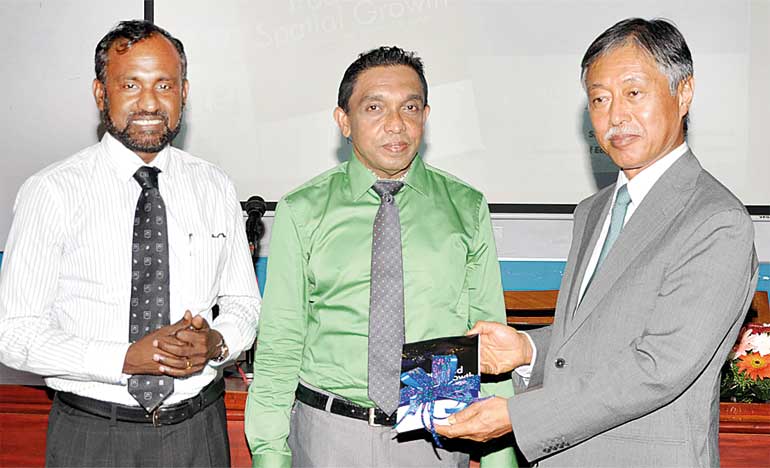Monday Dec 08, 2025
Monday Dec 08, 2025
Tuesday, 2 August 2016 00:01 - - {{hitsCtrl.values.hits}}
Sri Lanka Economic Association and the Department of Economics of the University of Colombo launched the book titled ‘Trade and Spatial Growth: Sharing Images from Japan and Sri Lanka’ authored by Professor Sirimal Abeyratne and Professor N.S. Cooray at the university premises on 28 July. The book was based on a research study funded by the Japan Foundation. The Chief Guest at the book launch was the Ambassador of Japan Kenichi Suganuma. It was reviewed by Professor H.D. Karunaratne, former Dean of the Faculty of Management and Finance, University of Colombo.
“Trade accelerates growth as well as spatial concentration of growth so that growth is uneven across geographical space of a country. Unlike trade-growth nexus, spatial growth has not received much attention in trade analyses.” While reviewing this conceptual and theoretical issue, the study shares experience of growth concentration in Japan and Sri Lanka – the former as an advanced country where its historical growth has dispersed significantly across the country and the latter as a developing country where its spatial growth has been concentrating in a single location.
 Japan Ambassador Kenichi Suganuma (right) receives the book from authors, Prof. Sirimal Abeyratne (middle) and Prof. N.S. Cooray
Japan Ambassador Kenichi Suganuma (right) receives the book from authors, Prof. Sirimal Abeyratne (middle) and Prof. N.S. Cooray
As countries begin to grow with trade expansion and global integration, economic activity and people tend to concentrate in creating dense locations across geographical space. There are valid economic reasons for people to concentrate in some places of a country rather than to spread everywhere, in order to invest, work, and live. Economic activities get concentrated because investors find these places offering better investment opportunities than elsewhere.
People gather in such places where economic activity concentrates, because they also find better opportunities than elsewhere in order to make use of their human resources in economic growth (work) and to derive benefits from growth (live). The underlying factors of spatial growth are analysed under four headings as benefits of agglomeration, costs of connectivity, degree of factor mobility, and the size of the markets.
The study reveals that there are significant spatial growth implications of the role of the government along with the country’s growth strategies and regional development approaches. Nearly 29% of people in Sri Lanka live in the Western province occupying less than 6% of the country’s land area, but contributing about half of total GDP. Although Colombo economic prosperity still has a long way to grow further, many have looked at it in a negative sense as an unfavourable outcome of trade liberalisation and globalisation. From a pragmatic point of view, the main issue in question is not the ‘too high’ economic mountain in the Western Province, but the ‘too low’ plains below them stretching over the rest of the country. This needs to be understood against the country’s long-standing regional and rural development strategies, policies, programmes and projects.
In Japan too, it is naturally difficult to avoid that there is a high-rise economic mountain in Tokyo Metropolitan Area, where 35 million people (that make up 28% of population) is packed in a 3.5% of land area, and contributes 32% of GDP. However, it does not dilute Japan’s distinguished regional economic concentration outside Tokyo in the prefectures such as Aichi, Osaka, Hiroshima, and Fukuoka, and more equitable distribution of per capita income across the prefectures. Spatial growth concentration does exist in Japan, but appears dispersed across the country – more along and around the Pacific Coastal Belt of the country than elsewhere.
The remote regions appear to have made a costly move to become inclusive in the mainstream growth process raising the questions on the historical regional development policies of the Japan too.
The study presents policy guidelines for Sri Lanka, given the fact that there is no economic reason to anticipate that growth would be even across all provinces in Sri Lanka. Neither it is possible to justify that growth would continue to concentrate in a single location as it has been in the past. There could be valid reasons why other locations of spatial growth have not yet emerged in the island.
What would be the desirable and viable level of concentration versus dispersion? How can Sri Lanka face the challenges and create conditions for realising this outcome? What is the facilitating role that the government can perform in operating at both central and sub-national levels? How do the political aspirations at sub-national levels fit into growth concentration that creates opportunities for sub-national entities to compete as well as to integrate? The study attempts to answer these questions on the basis of centripetal forces that pull economic activity and people to Colombo Metropolitan Area, and to advise facilitating spatial growth in a few viable and feasible locations in the island.